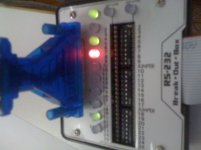Lord Nightmare
Member
- Joined
- Dec 19, 2008
- Messages
- 27
I know this is a major necropost but the proper way to get a votrax type n talk working is quite simple: first of all be sure you have the right power supply: a votrax personal speech system uses a power supply quite different to the one used on the votrax type n talk, despite using the same din-5 connector!
Secondly, the baud rate needs to be set properly; the type n talk uses a rather hacky way to do this: there are 8 dipswitches, and each one connects the clock input of an m6850 ACIA to a different clock rate divdied by a 4040 divider. You must have only ONE dip switch set or it will NOT work! (see the schematic at http://www.kevtris.org/Projects/votraxtnt/tnt_schematic.jpg)
Most people will probably want to set just dipswitch 8, for 9600bps.
The serial port, as far as I recall, is set to be a 'DTE' device and so requires use of a null modem cable to connect to a computer (which is another 'DTE' device). Flow control uses RTS and CTS lines. serial words are 8 bits long with no parity, and one stop bit, I believe. so the standard (with dipswitch 8 set) is 9600,N,8,1
As for data sent to the device, it is an unlimited text to speech engine using the "NRL" text-to-phoneme algorithm and a small dictionary of override words (to replace a few common ones which NRL doesn't pronounce properly).
You can also make it use votrax phonemes by starting a phoneme string with a ~, using ascii characters whose lower 6 bits control the phoneme spoken, and ending with a ?. The 64 votrax phonemes are documented here: http://www.sscnet.ucla.edu/geog/gessler/borland/votrax-phoneme-chart.jpg
The user manual for the type n' talk can be found here, in html-ized form:
http://members.tripod.com/werdav/txtospm1.html
LN
Secondly, the baud rate needs to be set properly; the type n talk uses a rather hacky way to do this: there are 8 dipswitches, and each one connects the clock input of an m6850 ACIA to a different clock rate divdied by a 4040 divider. You must have only ONE dip switch set or it will NOT work! (see the schematic at http://www.kevtris.org/Projects/votraxtnt/tnt_schematic.jpg)
Most people will probably want to set just dipswitch 8, for 9600bps.
The serial port, as far as I recall, is set to be a 'DTE' device and so requires use of a null modem cable to connect to a computer (which is another 'DTE' device). Flow control uses RTS and CTS lines. serial words are 8 bits long with no parity, and one stop bit, I believe. so the standard (with dipswitch 8 set) is 9600,N,8,1
As for data sent to the device, it is an unlimited text to speech engine using the "NRL" text-to-phoneme algorithm and a small dictionary of override words (to replace a few common ones which NRL doesn't pronounce properly).
You can also make it use votrax phonemes by starting a phoneme string with a ~, using ascii characters whose lower 6 bits control the phoneme spoken, and ending with a ?. The 64 votrax phonemes are documented here: http://www.sscnet.ucla.edu/geog/gessler/borland/votrax-phoneme-chart.jpg
The user manual for the type n' talk can be found here, in html-ized form:
http://members.tripod.com/werdav/txtospm1.html
LN
Last edited:

